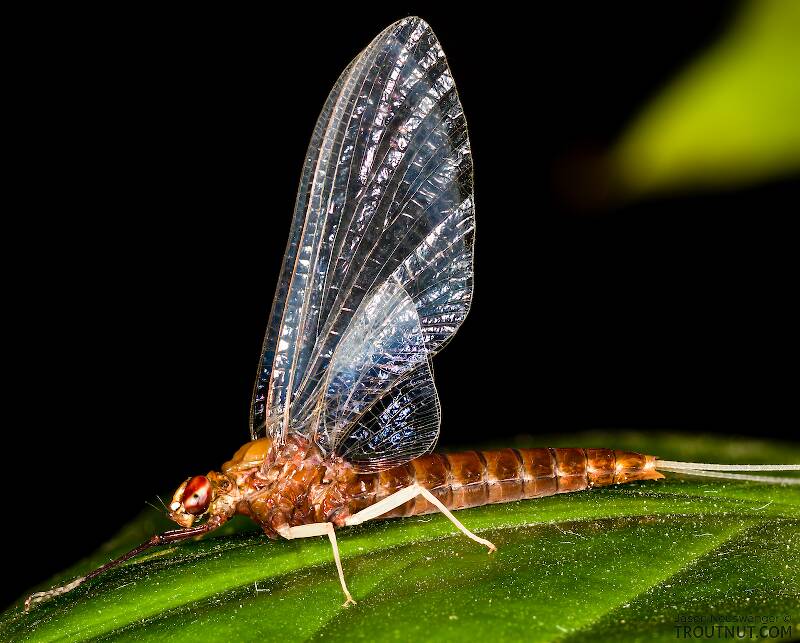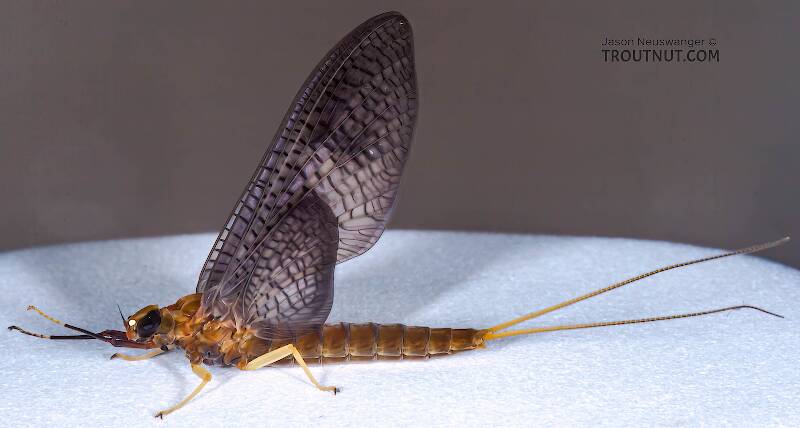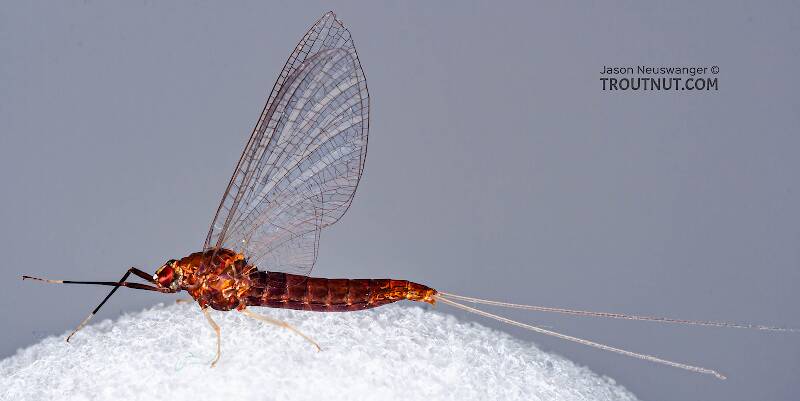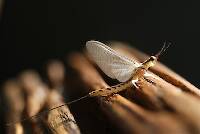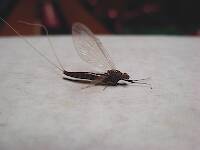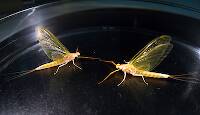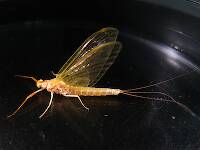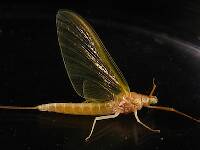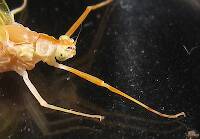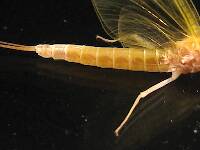
Salmonflies
Pteronarcys californica
The giant Salmonflies of the Western mountains are legendary for their proclivity to elicit consistent dry-fly action and ferocious strikes.
Featured on the forum

I caught this tiny larva without a case, but it seems to key pretty clearly to to Glossosomatidae. From there, the lack of sclerites on the mesonotum points to either Glossosoma or Anagapetus. Although it's difficult to see in a 2D image from the microscope, it's pretty clear in the live 3D view that the pronotum is only excised about 1/3 of its length to accommodate the forecoxa, not 2/3, which points to Glossosoma at Couplet 5 of the Key to Genera of Glossosomatidae Larvae.

Troutnut is a project started in 2003 by salmonid ecologist Jason "Troutnut" Neuswanger to help anglers and
fly tyers unabashedly embrace the entomological side of the sport. Learn more about Troutnut or
support the project for an enhanced experience here.
This topic is about the Mayfly Family Isonychiidae
See Isonychia for details. It is the only North American genus in this family.Example specimens
CraigK on Mar 26, 2012March 26th, 2012, 12:35 pm EDT
I think the Iso. b. female was referred to a generation or so ago as the white gloved howdy. I love those old names. Too bad there are no pics of Potamanthus (golden drake). They may be extinct (siltation and acid rain?)...talked with Charlie Meck about that a few years ago. A beautiful mayfly...an important hatch of years past. I couldn't find any ref. to Epherons. An important hatch for me in about any area of the country. This my first post...love the site...very nice photog. Lets see what the strange weather of the year does to the hatches and fishing for this year. Overall, I expect it can't be good. CK
PaulRoberts on Mar 26, 2012March 26th, 2012, 2:45 pm EDT
Don't think "Potamanthus" is extinct -except for the name. http://www.troutnut.com/topic/3534/yellowish-possibly-night-hatching-mayfly
Welcome!
Welcome!
Taxon on Mar 26, 2012March 26th, 2012, 3:05 pm EDT
Craig-
Congratulations on your first post. You will probably find it somewhat addictive.
Quite a while ago, the genus name was changed from Potamanthus to Anthopotamus. Here is a beautiful photo of one taken July 3, 2008 by Charley Eisenman in Nashville, Tennessee:

Congratulations on your first post. You will probably find it somewhat addictive.
Too bad there are no pics of Potamanthus (golden drake). They may be extinct (siltation and acid rain?)...talked with Charlie Meck about that a few years ago.
Quite a while ago, the genus name was changed from Potamanthus to Anthopotamus. Here is a beautiful photo of one taken July 3, 2008 by Charley Eisenman in Nashville, Tennessee:

Oldredbarn on Mar 26, 2012March 26th, 2012, 7:36 pm EDT
Nice find there Roger! I have only run across it once, years back, near here (southeast Michigan) on a deep spring fed pond. (?) I love the "bars" cross-hatch markings on the wings...It reminds me a bit of a beautiful "Light Cahill" we get here in June that used to be called Stenonema heterotarsale(sp?)...
Spence
Spence
"Even when my best efforts fail it's a satisfying challenge, and that, after all, is the essence of fly fishing." -Chauncy Lively
"Envy not the man who lives beside the river, but the man the river flows through." Joseph T Heywood
"Envy not the man who lives beside the river, but the man the river flows through." Joseph T Heywood
PaulRoberts on Mar 27, 2012March 27th, 2012, 6:40 am EDT
THey come off the Barge Canal in NY pretty well. I have an image of one that emerged in my river tank which I operated in Ithaca NY. Don't remember where that individual nymph was collected, but it was likely Fall Creek.
Kurt got some clean up to do on this thread I would think. I don't think Iso's were mentioned.
Kurt got some clean up to do on this thread I would think. I don't think Iso's were mentioned.
Konchu on Mar 27, 2012March 27th, 2012, 6:59 am EDT
one of my students just collected an Anthopotamus here in south central Indiana (quite ahead of schedule?), and I collected some last summer in SW Indiana, so the genus seems to be around, perhaps even thriving, here in the Hoosier state. i have zero doubt, though, that it has experienced local extinctions (extirpations) due to habitat changes, especially siltation in this region. there may be a number of extirpated species around Bloomington, including some ephemerellids and heptageniids, due to habitat alteration or loss.
Crepuscular on Mar 27, 2012March 27th, 2012, 8:54 am EDT
I have collected them on upper sections of the Yellow Breeches here in PA. But not many. I wonder if Gonzo has collected them there as well?
Entoman on Mar 27, 2012March 27th, 2012, 11:26 am EDT
Craig -
Welcome to the forum!
Paul -
Yeah, I can't edit the title, because it's linked to a taxon. When these threads morph (as they often seem to do), it would be nice if the topic originators would perhaps modify the titles to recognize this... Craig? But even this won't de-link it from the improper taxon. This, and avoiding multiple ID requests in the same thread would be a big help. Unfortunately this happens a lot. There's a lot of great commentary by the bug guys on this forum buried in unrelated topics.
Welcome to the forum!
Paul -
Kurt got some clean up to do on this thread I would think. I don't think Iso's were mentioned.
Yeah, I can't edit the title, because it's linked to a taxon. When these threads morph (as they often seem to do), it would be nice if the topic originators would perhaps modify the titles to recognize this... Craig? But even this won't de-link it from the improper taxon. This, and avoiding multiple ID requests in the same thread would be a big help. Unfortunately this happens a lot. There's a lot of great commentary by the bug guys on this forum buried in unrelated topics.
"It's not that I find fishing so important, it's just that I find all other endeavors of Man equally unimportant... And not nearly as much fun!" Robert Traver, Anatomy of a Fisherman
Martinlf on Mar 27, 2012March 27th, 2012, 4:28 pm EDT
Welcome Craig. While I worry about global warming, and do what I can in that regard, this year's warm weather and low water have led to the best dry fly fishing I've had for baetis in years.
"He spread them a yard and a half. 'And every one that got away is this big.'"
--Fred Chappell
--Fred Chappell
Konchu on Mar 28, 2012March 28th, 2012, 5:57 am EDT
by the way, i think the picture is Anthopotamus distinctus
Taxon on Mar 28, 2012March 28th, 2012, 3:18 pm EDT
Hi Luke-
PM sent.
by the way, i think the picture is Anthopotamus distinctus
PM sent.
Konchu on Mar 28, 2012March 28th, 2012, 3:24 pm EDT
PM returned!
Konchu on Mar 28, 2012March 28th, 2012, 3:25 pm EDT
For all: Anthopotamus may or may not be my strength. :} We shall see.
Entoman on Mar 28, 2012March 28th, 2012, 5:01 pm EDT
Any idea as to how big he is?
"It's not that I find fishing so important, it's just that I find all other endeavors of Man equally unimportant... And not nearly as much fun!" Robert Traver, Anatomy of a Fisherman
Taxon on Mar 28, 2012March 28th, 2012, 5:22 pm EDT
Kurt-
Sure, the body length was reported to be 9 mm. However, I would suggest the thread be retitled by CraigK, as the Isonychia bicolor title is rather confusing.
Sure, the body length was reported to be 9 mm. However, I would suggest the thread be retitled by CraigK, as the Isonychia bicolor title is rather confusing.
Entoman on Mar 28, 2012March 28th, 2012, 6:22 pm EDT
Roger -
Yes, the only post I made to this thread (see above) asked him to do just that. It's a shame since this thread (once it falls off the board) will never be accessible by those who may want to look into the critters under discussion in the future. That's why I've tried to hold off commenting.... But I can't help myself.:)
As to the species, based on the body size and eyes as described in McCafferty's paper on the subject (discussing the verticis group of this genus), I think we are "neglecting" the right choice here.:)
I would suggest the thread be retitled by CraigK, as the Isonychia bicolor title is rather confusing.
Yes, the only post I made to this thread (see above) asked him to do just that. It's a shame since this thread (once it falls off the board) will never be accessible by those who may want to look into the critters under discussion in the future. That's why I've tried to hold off commenting.... But I can't help myself.:)
As to the species, based on the body size and eyes as described in McCafferty's paper on the subject (discussing the verticis group of this genus), I think we are "neglecting" the right choice here.:)
"It's not that I find fishing so important, it's just that I find all other endeavors of Man equally unimportant... And not nearly as much fun!" Robert Traver, Anatomy of a Fisherman
Entoman on Mar 28, 2012March 28th, 2012, 6:29 pm EDT
On second thought - It's not gonna happen! When this thread has run its course (since we are committed now), I'm going to copy everything to a new topic in the proper genus and delete this one.
"It's not that I find fishing so important, it's just that I find all other endeavors of Man equally unimportant... And not nearly as much fun!" Robert Traver, Anatomy of a Fisherman
Konchu on Mar 28, 2012March 28th, 2012, 8:10 pm EDT
yes, neglectus is the elephant in the room; in a few days, I hope to consult my library and see what the original authors had in mind
Entoman on Mar 28, 2012March 28th, 2012, 8:45 pm EDT
Luke & Roger-
Silly puns aside, what I'm working off of is pretty dated and the paper acknowledged there's a lot to work out with this genus. The nymphs hadn't even been associated yet with this species. Frankly, having never seen one before I'm just basing my opinion on a few obscure lines in a paper and Schwiebert's descriptions in his revised Nymphs. You two may be right (just a caveat for CYA). :) Look forward to what you find out.
Silly puns aside, what I'm working off of is pretty dated and the paper acknowledged there's a lot to work out with this genus. The nymphs hadn't even been associated yet with this species. Frankly, having never seen one before I'm just basing my opinion on a few obscure lines in a paper and Schwiebert's descriptions in his revised Nymphs. You two may be right (just a caveat for CYA). :) Look forward to what you find out.
"It's not that I find fishing so important, it's just that I find all other endeavors of Man equally unimportant... And not nearly as much fun!" Robert Traver, Anatomy of a Fisherman
Konchu on Mar 29, 2012March 29th, 2012, 4:51 am EDT
it seems to me to have the body coloration (hard for me to tell on different computers), wing infuscation and maybe eyes of distinctus (very small vs. tiny in neglectus). the wing crossveins of distinctus are infuscated more than neglectus, and that seems to be the case here. but if it really is 9mm, then there's the chance it could be a larger version of neglectus, even though the wings point me more towards this being a small distinctus. however, there may be a little overlap of the upper size range of the one and the lower size range of the other, especially in the middle parts of the ranges (NY being north middle for the usually "larger" distinctus and almost southern for the "smaller" n. neglectus). if i was wrong with distinctus, it was based mostly on the wing infuscation characters. hard to say which ones are more or less reliable for IDs: size, body color, eyes, or wings. writing this somewhat on the fly (no pun intended), so I hope I didn't flop anything around.
Quick Reply
Related Discussions
Topic
Replies
Last Reply
1
Jun 15, 2012
by Crepuscular
by Crepuscular
0
May 3, 2007
by Troutnut
by Troutnut
1
Jun 12, 2007
by Troutnut
by Troutnut
2
Jul 2, 2009
by DayTripper
by DayTripper
6
Jun 20, 2008
by GONZO
by GONZO
13
Jul 25, 2014
by Millcreek
by Millcreek
14
Jun 15, 2012
by Entoman
by Entoman


